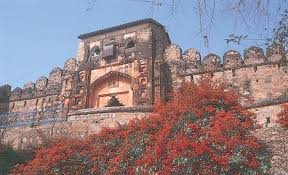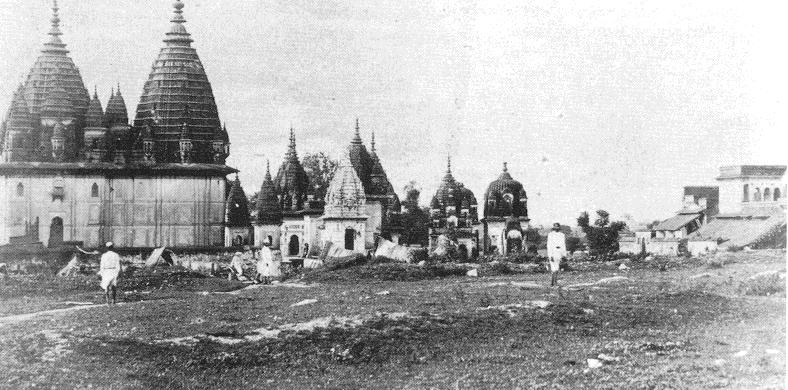.......


Jhansi is situated about 100 k. south of Gwalior and 30 kms. from Datia. Jhansi is the gateway to Bundelkhand. Jhansi is mainly known for the Jhansi fort and its ruler the Rani Laxmi Bai. Jhansi is a tiny finger of the state of Uttar Pradesh and extends into Madhya Pradesh.

Jhansi city, situated between the rivers Pahunj and Betwa is a symbol of bravery, courage and self respect. It is said that in ancient times Jhansi was a part of the regions Chedi Rashtra, Jejak Bhukit, Jajhoti and Bundelkhand.
Jhansi was a stronghold of the Chandela kings. Balwant Nagar was the name of this place. But in 11th. century Jhansi lost its importance. In 17th. century under Raja Bir Singh Deo of Orchha Jhansi again rose to prominence. Raja Bir Singh Deo had good relations with the mughal emperor Jehangir. In 1613 Raja Bir Singh Deo constructed the Jhansi fort. He died in 1627. After his death his son Juhar Singh succeeded him.
Maharaja Chattrasal Bundela of Panna was a good administrator and a brave warrior. In 1729 Mohammed Khan Bangash attacked Chattrasal. Peshwa Baji Rao(I ) helped Maharaja Chattrasal and defeated mughal army. As a mark of gratitude Maharaja Chattrasal offered a part of his state to Maratha Peshwa Baji Rao(I). Jhansi was also included in this part.
In 1742 Naroshanker was made the subedar of Jhansi. During his tenure of 15 years he not only extended the Jhansi fort which was of strategic importance but also constructed some other buildings. The extended part of the fort is called Shankergarh. In 1757 Naroshanker was called back by the Peshwa. After him Madhav Govind Kakirde and then Babulal Kanahai were made the subedars of Jhansi.
In 1766 Vishwas Rao Laxman was made the subedar of Jhansi. His period was from 1766 to 1769. After him Raghunath Rao (II) Newalkar was appointed the subedar of Jhansi. He was a very able administrator. He increased the revenue of the state. The MahaLakshmi Temple and the Raghunath Temple were built by him. For his own residence he constructed a beautiful building Rani Mahal in the city. In 1796 Raghunath Rao passed the subedari in favour of his brother ShivRao Hari.
In 1803 a treaty was signed between East India company and Maratha.
After the death of Shiv Rao his grand son Ramchandra Rao was made subedar of Jhansi. He was not a good administrator. Ramchandra Rao died in 1835. After his death Raghunath Rao (III) was made his successor. In 1838 Raghunath Rao (III) also died. The British rulers then accepted Gangadhar Rao as the Raja of Jhansi. Due to the inefficient administration during the period of Raghunath Rao (III) the financial position of Jhansi was very critical.
Raja Gangadhar Rao was a very good administrator. He was very generous and full of sympathy. He gave very good administration to Jhansi. During his period the local population of Jhansi was very satisfied.
In 1842 Raja Gangadhar Rao married Mannikarnika. After this marriage Mannikarnika was given the new name Lakshmi Bai, who led forces against British in 1857. She sacrificed her life to the cause of Indian Independence in 1858.
In 1861 the British Government gave the Jhansi fort and Jhansi city to JiyajiRao Scindia. Jhansi was then became a part of Gwalior state. In 1886 Britishers took back Jhansi from Gwalior state.

Jhansi is situated about 100 k. south of Gwalior and 30 kms. from Datia. Jhansi is the gateway to Bundelkhand. Jhansi is mainly known for the Jhansi fort and its ruler the Rani Laxmi Bai. Jhansi is a tiny finger of the state of Uttar Pradesh and extends into Madhya Pradesh.

| Tourist Attraction in Jhansi | |||||||||||||||||||||
 rani lakshmibai Jhansi fort The Jhansi fort was built by King Bir Singh Judeo of Orchha in the 17th century on the top of a hill, as an army stronghold. The Jhansi Fort offers excellent views from its ramparts. The British ceded the fort to Maharaja Scindia in 1858 but later exchanged it for Gwalior in 1866. The fort has been a witness to the fiery battle led by Queen Laxmi Bai. The fort consists of a tier of ramparts which varies in height from 5.5 m to 9 m. They are built of solid masonry and have ten gates: Khanderao, Datia, Unao, Orchha, Baragaon, Lakshmi, Sagar, Sainyar, Bhander and Jhirna. The breach made by the British under Sir Huge Rose is between the Sainyar and Jhirna gates. There is a temple inside the fort which is attended by a priest. There are beautiful temples of Lord Shiva and Ganesha inside the fort. The Karak Biji and Bhawani Shankar cannons of the queen are also kept here.
The palace of Queen Laxmi Bai or Rani Mahal is a fine piece of traditional architecture, which has now been converted into a museum. It houses a collection of archaeological remains of the period between the 9th and the 12th century AD and the sculptures excavated by the Archaeological Survey of India. On the first floor of the palace, decorative murals grace the ceiling as they used to do it when they resided here after the British annexed her kingdom. Chhatri of Gangadhar Rao The chhatri or cenotaph of Gangadhar Rao, the Rani Laxmi Bai's husband stands in a walled enclosure. This cenotaph is centred around a pavilion and devoid of frescoes. It has a quiet and nostalgic feet about it. A door leads to a reservoir or tank where local men bathe. Jhansi Museum Weapons, statues, dresses and photographs that represent the Chandela dynasty and a picture galley, are the main features of the Government museum. The Museum's folk art gallery is fascinating with its exhibits of finger painting from the walls of village huts. Other Places of Interest Laxmi Tal, Gangadhar Rao-Ki-Chhatri, Shri Kali Temple, Laxmi Bai Park, Laxmi Temple, Narayan Bagh, Jari Ka Math, Barua Sagar & Fort, Garhmau Lake, Karguan Jain Temple, Shrine of St. Jude Church. | |||||||||||||||||||||
| |||||||||||||||||||||
Jhansi city, situated between the rivers Pahunj and Betwa is a symbol of bravery, courage and self respect. It is said that in ancient times Jhansi was a part of the regions Chedi Rashtra, Jejak Bhukit, Jajhoti and Bundelkhand.
Jhansi was a stronghold of the Chandela kings. Balwant Nagar was the name of this place. But in 11th. century Jhansi lost its importance. In 17th. century under Raja Bir Singh Deo of Orchha Jhansi again rose to prominence. Raja Bir Singh Deo had good relations with the mughal emperor Jehangir. In 1613 Raja Bir Singh Deo constructed the Jhansi fort. He died in 1627. After his death his son Juhar Singh succeeded him.
Maharaja Chattrasal Bundela of Panna was a good administrator and a brave warrior. In 1729 Mohammed Khan Bangash attacked Chattrasal. Peshwa Baji Rao(I ) helped Maharaja Chattrasal and defeated mughal army. As a mark of gratitude Maharaja Chattrasal offered a part of his state to Maratha Peshwa Baji Rao(I). Jhansi was also included in this part.
In 1742 Naroshanker was made the subedar of Jhansi. During his tenure of 15 years he not only extended the Jhansi fort which was of strategic importance but also constructed some other buildings. The extended part of the fort is called Shankergarh. In 1757 Naroshanker was called back by the Peshwa. After him Madhav Govind Kakirde and then Babulal Kanahai were made the subedars of Jhansi.
In 1766 Vishwas Rao Laxman was made the subedar of Jhansi. His period was from 1766 to 1769. After him Raghunath Rao (II) Newalkar was appointed the subedar of Jhansi. He was a very able administrator. He increased the revenue of the state. The MahaLakshmi Temple and the Raghunath Temple were built by him. For his own residence he constructed a beautiful building Rani Mahal in the city. In 1796 Raghunath Rao passed the subedari in favour of his brother ShivRao Hari.
In 1803 a treaty was signed between East India company and Maratha.
After the death of Shiv Rao his grand son Ramchandra Rao was made subedar of Jhansi. He was not a good administrator. Ramchandra Rao died in 1835. After his death Raghunath Rao (III) was made his successor. In 1838 Raghunath Rao (III) also died. The British rulers then accepted Gangadhar Rao as the Raja of Jhansi. Due to the inefficient administration during the period of Raghunath Rao (III) the financial position of Jhansi was very critical.
Raja Gangadhar Rao was a very good administrator. He was very generous and full of sympathy. He gave very good administration to Jhansi. During his period the local population of Jhansi was very satisfied.
In 1842 Raja Gangadhar Rao married Mannikarnika. After this marriage Mannikarnika was given the new name Lakshmi Bai, who led forces against British in 1857. She sacrificed her life to the cause of Indian Independence in 1858.
In 1861 the British Government gave the Jhansi fort and Jhansi city to JiyajiRao Scindia. Jhansi was then became a part of Gwalior state. In 1886 Britishers took back Jhansi from Gwalior state.











No comments:
Post a Comment